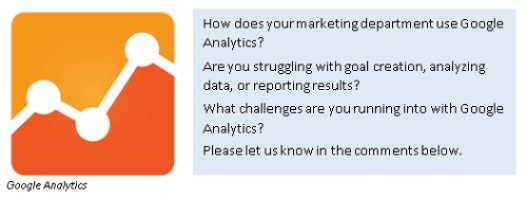In November 2012, NTEN and Idealware released the results of a survey studying nonprofit’s data use. Surprisingly, “outreach” data, or data relating to marketing, fundraising, and general communication activities, was commonly collected but infrequently used to inform future decisions. For instance, NTEN and Idealware discovered that 71% of those surveyed tracked the number of people on their mailing lists, yet only 23% used that data to inform spending and budgeting decisions. The surveys revealed that the largest internal barriers inhibiting non-profits from leveraging such data were time and the ability to collect and draw insights from the data.
The status of “outreach” data use in nonprofits, prepared by NTEN and Idealware
These same barriers exist for non-profits using Google Analytics. According to LunaMetrics, there are over 230 different metrics and dimensions available on Google Analytics for users to wade through. With so many possibilities it’s hard to know where to start. How does a manager determine which metrics are relevant and provide “actionable” information? To demystify web analytics, start with a website’s primary goals.
The traditional concept of a goal differs slightly than a goal in Google Analytics. While both types of goal seek a specific outcome, in Google Analytics a goal is a specific, measurable, action taken on a website, such as a page viewed or a PDF downloaded.
Think of it this way: An organization decides to create a monthly e-newsletter. The marketing manager adds an “e-newsletter” sign-up feature on the website.
- Goal: For visitors to learn more about the organization through an e-newsletter.
This goal doesn’t disappear in Google Analytics, but is redefined as a business objective.
- Business objective: Increase awareness of the organization’s performances, events, or other offerings through an e-newsletter.
- Google Analytic goal: Track how many visitors arrive at the “Thank-you for registering for our e-newsletter!” webpage.
Goal creation in Google Analytics
Effective use of Google Analytics identifies ways to measure business objectives in terms of trackable data. In the above example, “tracking” visitors means not only counting them, but also capturing information such as the referring website and which specific pages on the organization’s site the visitor viewed before clicking the “E-Newsletter Register” button.
This information could become actionable when the information “ties together specific and repeatable actions to observed results.” In order for data to become actionable identify a trend between the data and a specific action. Using the same hypothetical organization as an example, let’s say that over the course of one month, between June 1 and June 30, 400 visitors registered for the e-newsletter. Of those 400 visitors, 300 came from a blog post called “Kyle’s Time to Shine,” about a student at the organization who curated his very first art exhibit. That’s interesting - 75% of people who decided to register in that month did so after reading about Kyle. Based on this data, the marketing manager decides to publish another student profile piece the following month. At the end of July only 50 visitors signed up for the e-newsletter, yet 30 of those 50 visitors did so after reading the latest student profile piece.
User flow in Google Analytics
In this example, the actionable metric is the percent of e-newsletter registrants originating from the student blog post pages. The marketing manager repeatedly published student profile posts and found that both helped to prompt 60% or more of the total monthly new e-newsletter registrants. Guided by this data, the marketing manager may then decide to officially start a student blog series, and continue monitoring the same metric to see if the trend continues.
In the upcoming months I will research the applications of Google Analytics in nonprofit marketing departments. Specifically, I will investigate practical approaches to integrate organizational marketing activities into Google Analytics, collecting actionable information, and analyzing data for easier reporting and faster decision making.





